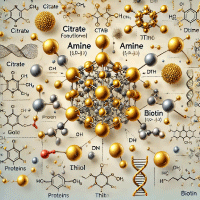Comprehensive Guide to Functional Groups for Gold Nanoparticles | NanoPartz™

List of Gold Nanoparticle Ligands, structure, primary use and binding affinity. Discover how various functional groups like citrate, amine, thiol, biotin, and more are used to functionalize gold nanoparticles. Learn how these groups enhance bioconjugation and targeting in fields like biotechnology, drug delivery, and nanotechnology.
Use Ctrl+f for Table Search
| Ligand | Structure | Primary Use | Binds To |
| Citrate | Tri-carboxylate anion (C₆H₅O₇³⁻) | Reducing and capping agent for nanoparticle stabilization | Gold surface |
| NPC | Nanopartz Proprietary | Surface modification for enhanced stability in aqueous systems | Metal oxides and gold surface |
| CTAB | C₁₆H₃₃N(CH₃)₃⁺ Br⁻ (Quaternary ammonium surfactant) | Stabilizing agent in nanoparticle synthesis | Gold nanoparticles |
| PEI | Branched polymer with amine groups (-NH₂) | DNA binding and surface coating | DNA, RNA, and negatively charged surfaces |
| PAH | Linear polymer with primary amine groups | Layer-by-layer assembly in coatings | Negatively charged molecules, DNA, proteins |
| PAA | Polymer with carboxyl groups (-COOH) | Stabilization and surface functionalization | Metal oxides, cations, proteins |
| PVP | Linear polymer with pyrrolidone groups | Stabilization in nanoparticle synthesis | Hydrophobic surfaces, metal nanoparticles |
| BSA | Protein with amino and carboxyl groups | Protein coating and surface blocking | Metal surfaces, proteins |
| Tannic Acid | Polyphenol with multiple hydroxyl (-OH) groups | Reducing and stabilizing agent | Metal surfaces, proteins |
| SDS | C₁₂H₂₅SO₄⁻ (anionic surfactant) | Surfactant for stabilization | Hydrophobic surfaces, proteins |
| Bare | No modification | Basic form of nanoparticles for further functionalization | None |
| Alkyne | Carbon-carbon triple bond (-C≡C) | Bioconjugation via click chemistry | Azides |
| Amine | -NH₂ | Surface functionalization and bioconjugation | Carboxyl groups |
| Azide | -N₃ | Click chemistry for bioconjugation | Alkynes |
| Biotin | Vitamin B7 derivative | Bioconjugation for targeted delivery | Streptavidin, neutravidin |
| Carboxyl | -COOH | Functionalization for protein and peptide conjugation | Amine groups |
| DBCO | Strained alkyne | Copper-free click chemistry | Azides |
| GSH | Tripeptide with -SH groups | Surface functionalization and antioxidant | Metal surfaces, proteins |
| HisTag | Histidine residue sequence | Protein purification | Nickel (Ni²⁺) in Ni-NTA columns |
| Hydroxyl | -OH | Surface functionalization and hydrogen bonding | Hydrogen bonds with various molecules |
| Maleimide | -C₄H₄O₂N | Crosslinking for bioconjugation | Thiol groups |
| Methyl | -CH₃ | Hydrophobic surface modification | Hydrophobic molecules |
| Neutravidin | Biotin-binding protein | Biotin-streptavidin conjugation | Biotin |
| Ni | Nickel-Nitrilotriacetic acid complex | Protein purification | His-tagged proteins |
| NHS | Reactive ester | Amine conjugation | Amine groups on proteins or molecules |
| Streptavidin | Protein that binds biotin | High-affinity binding in bioconjugation | Biotin |
| Thiol | -SH | Bioconjugation and surface functionalization | Gold, maleimide, metals |
| Oligo (ssDNA) | Single-stranded DNA | DNA hybridization and molecular diagnostics | Complementary DNA/RNA |
| dsDNA | Double-stranded DNA | Gene delivery and molecular sensing | DNA-binding proteins |
| RNA | Single-stranded RNA | Gene silencing and sensing | Complementary DNA/RNA |
| Peptides | Chains of amino acids | Targeted delivery and receptor binding | Proteins, receptors |
| Antibody | Y-shaped protein | Targeted detection and delivery | Specific antigens |
| Secondary Ab | Antibody binding to primary antibodies | Detection in immunoassays | Primary antibodies |
| SAMs | Self-assembled monolayers | Surface functionalization for better stability | Metal surfaces, typically gold |
